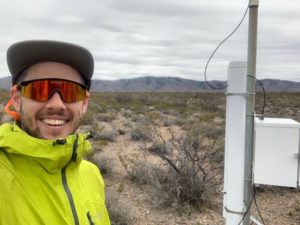Save the date for Zac Keller’s MS thesis defense on November 2nd at 12:00 PM (NM)/11:00 AM (AZ). Zac is a graduate student in the Enrique Vivoni Lab at Arizona State University. Link: https://asu.zoom.us/j/3558647087 Passcode: CiA
Runoff Connectivity, Controls, and Evolution During the North American Monsoon

Abstract: The American Southwest is one of the most rapidly growing regions of the United States, as are similar arid regions globally. Across these landscapes where surface water is intermittent and variable, groundwater aquifers recharged by surface waters become a keystone resource for communities and are consumed at rates disproportional to recharge. In this study, I focus on the controls of runoff generation and connectivity at both hillslope and watershed scales along a piedmont slope. I also investigate the effects of plant phenology on hydrologic connectivity and runoff response at the hillslope scale during the summer monsoon season. To carry out this work, I combine existing hydrologic instrumentation, a new set of runoff plots with high-resolution monitoring, near-field remote sensing techniques, and historical datasets. Key analyses show that a rainfall intensity (I30) of 10 mm/hr yields runoff production at three scales (8, 12700, and 46700 m2). Rainfall, runoff, and soil moisture observations indicate a Hortonian (infiltration-excess) dominated system with little control imposed by antecedent wetness. Hydrologic connectivity analyses revealed that <15% of rainfall events generate runoff at the hillslope scale, with only a further 20% of the runoff plot production leading to discharge at the outlet. Vegetation was observed to effect Individual plot runoff response to rainfall. The results of this study show that 1) Rainfall intensity is a large control on runoff production at all three scales (8, 12700, and 46700 m2), 2) Proportions between bare and vegetated space effect runoff production at the hillslope scale, and 3) Runoff connectivity decreases, and channel losses increase as you move downstream on an individual storm basis and across a 30-year historical record. These findings indicate that connectivity from the hillslope to outlet scale can be an evolving process over the historical record, reliant on both rainfall intensity, plant and bare soil mosaics, and available channel storage.